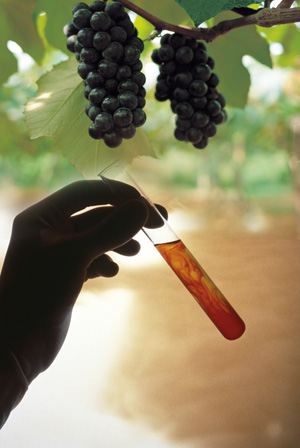
Features
Production
Research
B.C. researchers hope genomic research will make wine fine
hope genomic research will make wine fine
March 31, 2008 By Fruit & Vegetable
Steven Lund’s career as a plant
biologist and his passion for a good glass of wine have intersected in
a way that could help grape growers produce high-quality wines from
year to year.
 Steven Lund’s career as a plant biologist and his passion for a good glass of wine have intersected in a way that could help grape growers produce high-quality wines from year to year.
Steven Lund’s career as a plant biologist and his passion for a good glass of wine have intersected in a way that could help grape growers produce high-quality wines from year to year.
For consumers, the marriage of science and the art of wine making would mean consistently buying wine that’s magnificent instead of musty, fantastic not flat.
Lund and his colleague Joerg Bohlmann, of the University of British Columbia, are trying to learn more about what makes grape berries flavourful enough to create a tasty wine.
The mix of volatile organic compounds, or VOCs, in a finished wine is partly responsible for “whether you find the bouquet and entry from a newly opened bottle to be a pleasant experience or the basis for a scowl and a wrinkle of the nose,” says Lund.
Volatile organic compounds are the chemicals that give plant foods like tomatoes, strawberries and onions their distinct tastes and smells.
“We want to understand the molecular biology in the plants underlying how these compounds are created in (wine) grapes,” said Lund, an assistant professor at the University of B.C.’s Wine Research Centre.
To do that, they’ll study environmental factors such as light, water and nutrients available to the grape berries.
A major portion of Lund’s research involves learning more about the grapevine’s genetic makeup to understand how hard, green berries mature into soft, dark red ones.
The way grapes are cultivated in the vineyard each season affects the production of volatile organic compounds and make a wine fine, Lund said.
“How is all that controlled and is there a way we can start to speed it up to avoid fall frosts?”
Ultimately, Lund and Bohlmann hope to develop an instrument that will allow grape growers to monitor changes in the berries they couldn’t otherwise see. From there, growers could fine-tune practices like irrigation, pruning of leaves, sun exposure and the type of yeast strain they use from season to season.
“Canadian wine makers make lots of fine wines,” Lund said.
“What we’re hoping to do is provide information such that the growers and the wine makers can produce more consistent, high-quality wines that’ll translate into more flavourful, balanced wines.”
Lund’s work, funded by Genome Canada, is in collaboration with research in Spain, where scientists are studying table grapes – a huge industry in that country.
Lund said wine makers have shown an interest in his research, although not all will want to change their current practices.
“Some of them, for the next few centuries, are not going to want to use these tools and I fully respect that because they want to do it the old-fashioned way,” he said. “But some medium- to larger-size producers who are technology driven and who are very production driven, they may want to use these tools for more consistent quality.”
Canada is the youngest wine-producing region in the world, but business has been booming in the last decade, mostly in Ontario, B.C., Quebec and Nova Scotia.
According to the B.C. Wine Institute, wine sales in B.C. alone topped $131 million last year, up from $24 million a decade earlier.
The hike in sales came after 1990, when the quality of wines improved vastly because vineyards replanted their crops using European grapes and introduced varieties like Merlot and Chardonnay, said Jeff McDonald, spokesman for the institute.
Wine critic Anthony Gismondi said he’s all for genomic research that could improve the quality of wine even further, especially if it reveals the secrets of how grapes ripen.
“In a climate like British Columbia’s where it’s a short growing season, I would say everybody’s trying to find a solution to getting those grapes physiologically ripe at an acceptable time, like in late September, early October, instead of November,” Gismondi says.
“Since I’ve been looking at wine for 25 years they’ve managed to chop a week or two off that ripening period by using viticultural techniques right in the vineyard – different canopies, different ways they grow the grapes, how many bunches they hang. So for me, it’s just another step.”
While Lund’s research may take another five to 10 years, Gismondi says it would be well worth the wait.
“Any science that’s applied to the Canadian wine industry should be widely accepted by people because so little science has been thrown at it,” he says.
“If you look at Australia and all the rest of the major competitors, the science going on is fierce so I think it’s great if we’re finally using our own resources to get some answers.”
Courtesy of CP
Print this page